Films about Somewhere
Elsa Abderhamani, James Greenway, Marie Menken und Helena Wittmann
Eingeladen von Silke Nowak und Astrid Rostaing
17. Juli 2015
Im Garten der Smaragdbar, Prinzenallee 80, 13357 Berlin
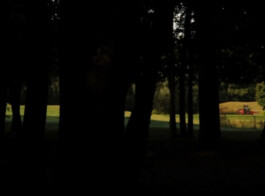
Elsa Abderhamani, Apremont, 8 min., 2014

Marie Menken, Glimpse of the Garden, 5 min., 1957
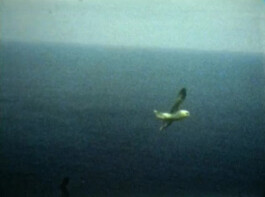
James Greenway, Imagin'd Corners, 4 min., 2010
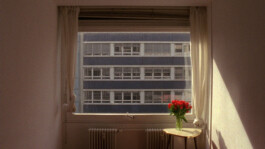
Helena Wittmann, 21,3 °C, 16 min., 2014
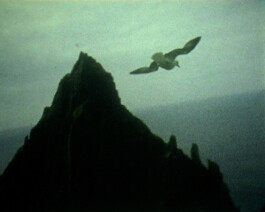
James Greenway, Imagin'd Corners, 4 min., 2010
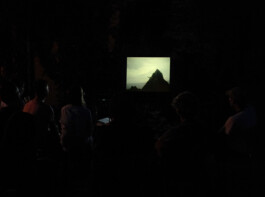
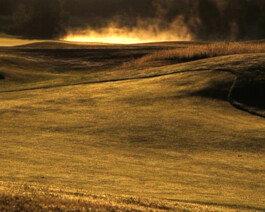
Elsa Abderhamani, Apremont, 8 min., 2014
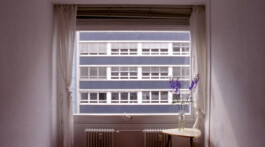
Marie Menken, Glimpse of the Garden, 5 min., 1957
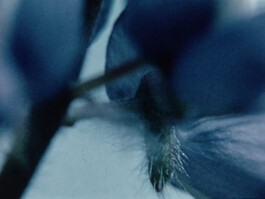
Marie Menken, Glimpse of the Garden, 5 min., 1957
English version below
In den ausgewählten Kurzfilmen wird vordergründig wenig erzählt, sondern vielmehr mit Abstand betrachtet und erfasst. Die unterschiedlichen spezifischen Herangehensweisen, vor allem die gewählten Kamerastandpunkte oder Kamerabewegungen, erlauben uns einen neuen Blick auf die von den Filmemachern gewählten Sujets. Menschen stehen in den Filmen weniger im Mittelpunkt, vielmehr sind es die Orte - Gärten, Felsen, Sportplätze oder Büroräume - die die Hauptrolle spielen.
Elsa Abderhamani stellt uns in Apremont eine sonderbare Landschaft vor. Wildnis und kultivierte Natur treten in Erscheinung, ebenso Menschen und Fahrzeuge. Beim Dreh hielt sich Abderhamani an gesetzte Regeln: So bewegte sie sich nur in einem bestimmten Umkreis und folgte von hier aus mit der Kamera den Bewegungen von Menschen. Wir sehen einen Golfplatz, der in den frühen Morgenstunden für die Spieler vorbereitet wird; dieses Szenario beobachtet die Filmemacherin mit der Kamera, ohne dabei zu bewerten.
James Greenway zeigt in seinem Film Imagin’d Corners das Meer, Felsformationen und Möwen an der irischen Küste. Greenway verfolgt mit der Kamera einzelne Vögel oder kleine Gruppen von Vögeln. Die Möwen entfernen sich, nähern sich wieder an und verschwinden gelegentlich hinter Felsen. An der selben Stelle filmte 1976 Werner Herzog die Schlussszene von Herz aus Glas, einen Film, in dem es um den Ruin einer Glasbläserei geht. Im Entstehungsjahr von Imagin’d Corners befindet sich Irland in einer ökonomischen Krise.
Für Glimpse of the Garden begab sich Marie Menken mit forschendem Blick in den Garten eines befreundeten Künstlers. Sie filmte das große Ganze und die kleinen Details. Wir sehen die Anordnung der Pflanzen im Garten, Steine, einen See, im Hintergrund ein Haus aber auch Regenwasserperlen an einem Blumenstiel, Blütenkelche, feine Haare, die Struktur von Blättern und Lamellen und Stacheln von Kakteen. Dazu hören wir sich wiederholendes Vogelgezwitscher. „Wenn man ihre Filme das erste Mal sieht, scheint es, als sei da nichts … gleichzeitig geht es um alles, alles, was wir sind.“1
In Helena Wittmanns Film 21,3 °C schauen wir in einen Raum und blicken gleichzeitig aus seinem Fenster. Dahinter sehen wir eine Fassade mit weiteren Fenstern. Während des Filmes verändert sich wenig, das wenige, das sich verändert, wird umso wichtiger: Blumen auf dem Tisch werden ausgetauscht, Lichtverhältnisse im Raum verändern sich mit der Tageszeit. Außerdem sind Geräusche zu hören: Jemand übt auf einem Klavier, wir hören eine Baustelle. Wittmann arbeitet mit reduzierten filmischen Mitteln: Licht, Schatten, Geräusche. Nur die Temperatur im Raum verändert sich nicht, sie beträgt 21,3 °C.
1 Jonas Mekas in Kurzfilme und Filmgedichte von Marie Menken – Zusammengestellt von Ute Aurand, 1994
***
What is out there? Are we the passive observers of a dominating visual reality? Should we try to invent ways of constructing our own vision and imagine other spheres of reality? In their moving images, the invited artists seem to propose a viewpoint from which they can alternate between seizing and admiring the world as is, and choosing to focus on an aesthetical experiment. Here are four liberating meta-naturalistic works that exist somewhere in between framed improvisation and scenographic escapism…
In Apremont, Elsa Abderhamani presents a strange landscape. Characters and machines appear and mingle in a wild and maintained nature. Apremont is part of the series Tout autour (All around). This series of sequences has been directed according to certain rules of cartography: by marking out a perimeter and by following people and animals in their environment. Here, we see a golf course, which is being prepared for the players in the early morning. Through her camera, the filmmaker observes this scenario without judging it. “Instants, positions and crossings are being noted. A long scouting work precedes the shoot. We feel there
could be an after – an event that would make everything tumble yet the tension inscribes itself elsewhere, where it is not expected.”
In Imagin’d Corners, James Greenway films the see, rocks and seagulls on the Irish coast. He follows single birds as well as small groups of birds. The seagulls take off, approaching again and disappearing occasionally behind the rocks. This is where, in 1976, Werner Herzog filmed the final scene of Herz aus Glas (Heart of Glass), a film about the collapse of a town’s economy, based on the production of a precious ruby glass. In 2010, Ireland was dealing with an economy crisis. “In composing imagery and language that make transparent my processes of association, I create an aesthetic logic that deals with the sense of latent otherness, present
in the expectation and observation of change. An accumulation of thoughts that leads to a gradual unveiling of knowledge.”
For Glimpse of the Garden, Marie Menken undertakes a close gazing search into the garden of a friend. She films the whole picture and the small details. We see the arrangement of the plants in the garden, some stones, a lake, a house in the background as well as rainwater beads on a flower stem, calyx, fine hair, the structure of leaves and blades, and spines of cacti. We can also constantly hear repetitive bird twittering. "When you see her films for the first time, it is as if there was nothing there... yet at the same time it is about everything, everything that we are.“1
In Helena Wittmann’s 21,3 ° C, we are looking into a room as well as outside of it through its window. Behind the latter we see a façade that is filled with more windows. While the film itself changes little, the little that is changing becomes even more important: flowers on the table are being replaced, the lighting conditions of the room change as the day passes by. In addition, noises can be heard: someone is practicing on a piano, and we hear a construction site. Wittmann works with reduced cinematic means: light, shadows, noise. Only the temperature in the room does not change, it is 21.3 ° C.
1 Jonas Mekas in Kurzfilme und Filmgedichte von Marie Menken – Zusammengestellt von Ute Aurand, 1994